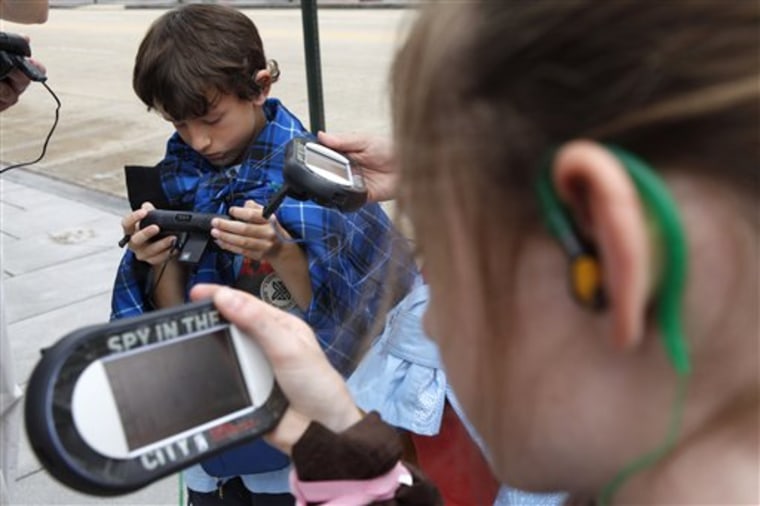An Ohio family of five recently went undercover in the nation's capital to help foil a cyber "terrorist attack." Their attire wasn't very suspicious: Shorts, T-shirts and jackets tied around their waists.
They were playing a new game at the International Spy Museum that sends tourists trolling through the city with handheld GPS devices to search for clues and codes to stop the attack before it starts.
The game, called "Spy in the City," was developed by former intelligence officers who want to teach the public a bit about their craft.
Carol Metzger, Brock Sturgeon and their three kids — Brooke, 11, Luke, 8, Alaina, 6 — thought they were up to the task, squeezing it in with a recent beach vacation in Delaware and a trip to Capitol Hill.
The mission: Find a hidden password to deactivate a terrorist device that could wipe out computers in the nation's capital. Players also must test clues from a source, code-named Catbird, to see if he can be trusted.
The first clue — a photo of their first destination — sends the quintet down the block to an old bank's night deposit box, then on to Ford's Theatre where Abraham Lincoln was shot and past the real FBI headquarters.
Game creators at the Spy Museum believe their game is a first of its kind, and they're planning more scenarios with varying levels of difficulty.
"The old days of a museum being just dusty artifacts in a display case that you walk by and admire, I think are long gone," said Peter Earnest, the museum's executive director who was in the CIA for 35 years.
Games, in fact, could play a big role in keeping museums relevant in the future, according to a recent American Association of Museums lecture by Jane McGonigal of the California-based Institute for the Future. She urged curators to recreate museums as places where visitors can interact, perhaps through games that solve real-world problems, and have fun at the same time.
The spy museum has been a popular draw for about 700,000 visitors a year since opening in 2002, despite its $18 admission fee. It has also benefited from the buzz of spy-themed movies and video games over the years. Recently, Angelina Jolie was filming at some of the same D.C. sites as those in the museum's game for the upcoming spy movie, "Salt."
That blend of pop culture, reality and a dose of education is key for how the museum hopes to nab visitors willing to pay $14 to play.
"You actually get to feel what it's like to be a spy," said Anna Slafer, the museum's education director. "That's what our public has told us they want."
The plot is based on a combination of real spy stories, the creators say. One was the Kitty Hawk case, in which the FBI used a double agent to help identify Soviet intelligence officers.
It also draws on practices that date back to the days of George Washington, who used secret, invisible writing with some of his agents. The spy game includes similar secret messages the players must uncover.
"When you don't know who to trust, when you don't know the answers, when you're sort of dropped into a situation and you're not sure what to do, that's real espionage," Slafer said.
Slafer said the museum's game can spark curiosity among players about real challenges the intelligence community faces, namely the idea that terrorists would try to knock out computer systems.
"With this particular plot and in this city, the idea of cyber warfare is very real," she said. The game is not "just run, run, run, fun, fun, fun. It's really more reflective."
The players find clues at the National Archives and in small fountains and statues. The toughest task is decoding a message from the words of the First Amendment, engraved in stone at the Newseum, a journalism museum on Pennsylvania Avenue.
The Metzger and Sturgeon family, from Findlay, Ohio, completed the mission, despite a few wrong turns on city streets.
Brock Sturgeon, 38, said he liked it but felt like "a fish out of water" as they tried to find their way.
"Keeping track of where you're at is kind of hard," he said. "I don't think it's for little kids."
Brooke and Luke said the game was fun and that they might like to be spies someday. "I'm sneaky like that," Luke said, hiding behind a museum display.
It didn't always hold the attention of younger sister, Alaina, though. By the end she had other thoughts: "I'm hungry."
The family didn't quite foil the terrorist plot on their own, after hitting the wrong button and failing to deactivate the cyber terrorism device. "Spy agents" who were directing the operation had to step in.
"Although your work today wasn't stellar," they were told by spy HQ, "we definitely think you have potential as a covert spy agent."
